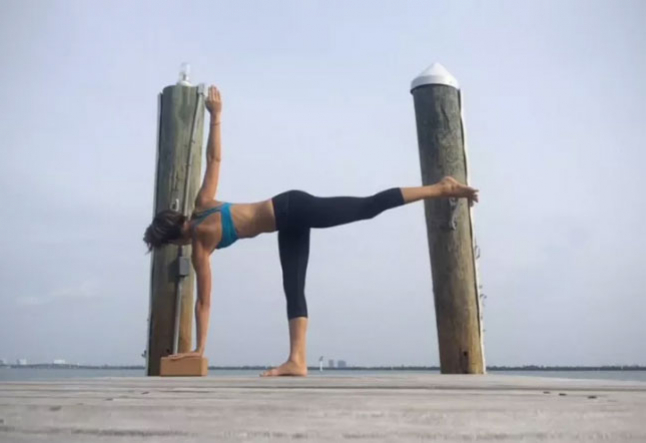revolved half moon (parivrtta ardha chandrasana)

sailing to the moon
how? revolved half moon (parivrtta ardha chandrasana)
Start in uttanasana (standing forward bend pose), then come onto the fingertips and walk the hands forward to elongate the spine. For a right-facing twist, lift the left leg up so that it’s parallel to the floor. A slight internal rotation of the left thigh and leg will enhance the ability to lengthen the spine without compression of the lower back. Stabilize the pelvis by firming the outer hip of the standing leg in towards center.
The twist action comes from the turn in the shoulders and the contraction-and-release action of the abdominal muscles. In opposition to the left leg lifting, reach the right arm up to the sky. Lengthen the shoulder blades down the back, so that you can rotate the torso while maintaining length at the back of the neck and chest.
As you inhale, relax and allow the spine to lengthen with the breath; and as you exhale, contract the abdominal muscles and twist. Begin gazing downward, and if appropriate, slowly track your gaze upward toward your top thumb.
A great preparatory pose is the lunge twist. It’s the exact same posture, with the only difference being that this pose has a bent knee. Another great warm-up is a supta padangusthasana variation (reclining big toe pose with twist). Lie on your back and take a strap to your left foot. Straighten the leg and take the leg over to the right side. Relax, breathe and expand!
who As one who mainly teaches at sunrise, my dawn motivation is to help the student transition from the morning slumber into a state of focused awareness. Practicing early in the morning is challenging in many ways. For most, the hardest asana is the getting-out-of-bed asana, especially when the alarm goes off and it’s dark and cold outside. The body is a very different creature at that time. Lethargy from a night’s sleep makes the muscles tight and the mind cloudy, so typically easy postures become more challenging to embody. The focus of practice then becomes the process of waking up. As the shift from darkness into light brings forth the new day, we can use the morning metaphor for our own daily awakening. That is, the movement that evolves out of stillness, conscious awareness that arises out of the dream state, and the search for balance that comes out of indifference. why Parivrtta ardha chandrasana (revolved half moon pose) is both a balance pose and a twist. Nothing wakes you up quite like standing on one leg. Your attention to detail is heightened as you work toward finding the alignment that will ultimately bring you into balance. Twists stimulate and invigorate the core musculoskeletal system of the spine, including the pelvis and shoulders. It is through the entire body working harmoniously, and in symphony with the breath, that we can reap the awakening benefits of a twist. The circulatory system and internal organs are also stimulated and cleansed as a result of the twisting action.
Read next >> open the heart